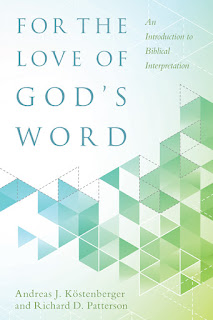AUTHOR: Andreas J. Köstenberger and Richard D. Patterson
PUBLISHER: Grand Rapids, MI: Kregel Academic, 2015, (448 pages)
Many Christians believe in the importance of studying the Word of God. They love and revere the Bible. They spend hours studying it and do devotions with it. They organize Bible studies to understand more about God. Sometimes, there is a danger of being too subjective by letting our own philosophies and feelings dominate what the biblical texts say and mean. What are the interpretive principles behind understanding and applying the Word of God?
This is an abridged version of an earlier book entitled, "Introduction to Biblical Interpretation." In a nutshell, the authors had earlier proposed a hermeneutical triad that comprises of historical contexts, literary genres, and theological implications (I call it HLT) in their nearly 900 pages length original. This edition is not only simplified but the contents reduced by 50% in order to cater for a less academic audience. From exegetical examples to bibliographical listing, advanced material to technical content, the authors are hoping that the book will benefit more lay readers and general audiences, especially the more eager learner of interpretive methods. With clear outlines and suggestions for learning, each chapter is refreshed to be more reader friendly and easier to reference. At the same time, all biblical interpreters are charged with this one single task: Interpret the sacred text with reverence and accuracy.
I like the way the authors begin with the need for humility. This is so important as having knowledge can puff up rather than edify the body. It means learning as being equipped to do good work. It means listening to the text and sharpening our spiritual perception. It also means that we are changed from the inside out. The Hermeneutical Triad is the author's way of helping us submit humbly to God by being respectful of the historical contexts; being sensitive to the literary genres, and being actively engaged with the theological implications of whatever passages we are studying. Each chapter comprises key guidelines for interpretation, key words to notice, and assignments to put what we read into practice. The entry outline helps readers to keep track of where they are going in this abridged but still sizeable volume. I like the simplified description and the brevity of each section. The supporting tables and illustrations drive home the pointers the authors try to make. I appreciate the conclusions accompanying each chapter because it is good pedagogy to summarize and to repeat important points. Overall, this follows the general teaching paradigm:
- First, I tell you what I am going to say
- Second, I say it.
- Third, I summarize what I have said.
Rating: 4.75 stars of 5.
conrade
This book is provided to me courtesy of Kregel Academic in exchange for an honest review. All opinions offered above are mine unless otherwise stated or implied.

No comments:
Post a Comment